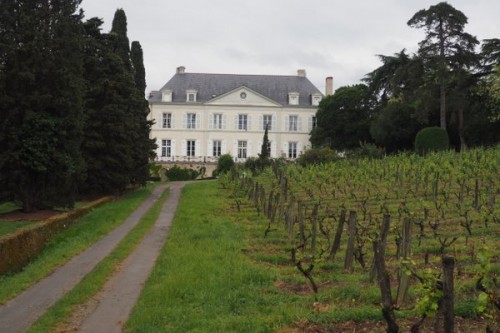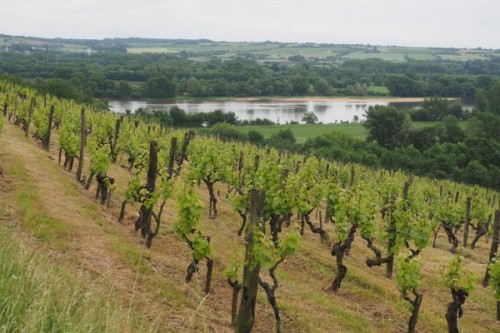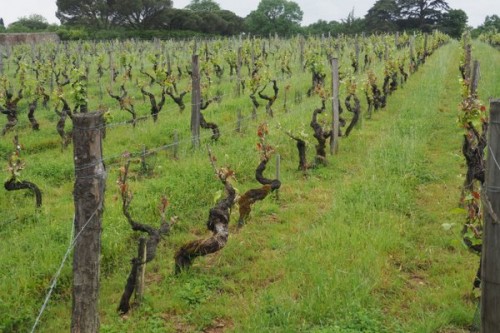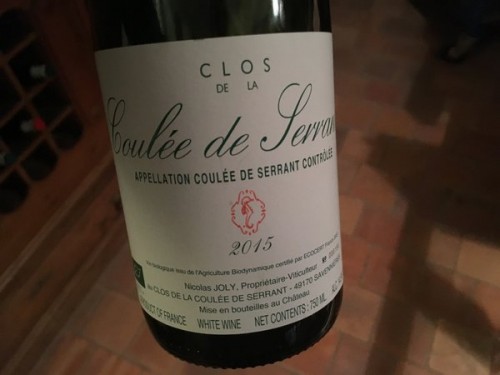
La Coulée de Serrant (Chateau de la Roche aux Moines) is a domaine with a narrow focus. It’s just whites. Just Chenin Blanc. Just dry wines. But it is this narrow focus that has contributed to its fame. These are distinctive wines from a distinctive terroir, and they are not without controversy. Some regard this as one of the top domaines in the Loire; others think that in some cases the winemaking obscures the terroir.
We’re in Savennières, here, a small appellation of just 150 hectares, but a famous one. We’re out of range of the limestone that is a common theme in many parts of the Loire, and are entering the territory of schist, granite, sandstone and even sand. The soils can be quite complex.

Proprietor Nicolas Joly has become famous as much for his advocacy of biodynamics, as he has for his wines. He did the first trial hectare with biodynamics in 1980, then converted the whole estate in 1981, and then certified with Demeter in 1984. Soils here are mainly slate, and the Coulée has very thin topsoils of just 10-15 cm, while it’s a bit deeper in Roche aux Moines at 60-70 cm and for the Savennières vineyards it’s a metre and a half, with a mix of sand and clay.
‘When my father took over the estate there had only been a couple of years of pesticides or weedkillers,’ says Virginie Joly, who now pretty much runs things, acknowledging that her father had actually bought them. ‘The soil was still there and had some strength. Now, after 20 years of chemical industry, it would be much harder to convert.’

There’s not much winemaking here, says Virginie Joly, daughter of Nicolas and the current winemaker. She harvests different parcels at different times, and then presses the grapes. Depending on whether or not there is botrytis she might or might not add a bit of sulfur dioxide at this stage. There are two pneumatic presses so that this isn’t a bottleneck in the process, and the juice goes straight from the press into barrel, which are 500 litres in size. These are bought new, but renewed very slowly, and the last time Coulee de Serrant bought a barrel was in 2001. Fermentation takes place, and then there is one racking just before filtration.
It’s at this point that Nicolas Joly comes in and takes over from his daughter. ‘The idea is not to do anything in the cellar if you are able to do deep farming. From spring to fall you mover from a tiny bud to several tons of matter per hectare, every year. If you take the water away, it is dry matter. 94% of that is photosynthesis. When you start to understand that in depth you realise that the earth doesn’t possess life. We receive life because we are a member of the solar system. If we were isolated from this, everything would die. There is a system that converts buds into grapes. How can we use this system?’

He continues, ‘this is called biodynamie. It is a mobile phone: you can talk to someone 10 km away through a wavelength. The information of life: cosmic wavelengths are reaching all the earth. We connect to what we need. By filling the solar system with all these wavelengths – there are billions of wavelengths – we are weakening the system that provides life on earth. This is a forbidden topic because there are huge economic interests.’ Joly maintains that communication satellites are disrupting the organization of the atmosphere.
‘People my generation started biodynamic for the truthfulness of the taste,’ says Joly. ‘Now it is the safety of the taste: you don’t want to poison yourself.’ He referred to a €450 Pomerol that was found to contain 22 dangerous molecules in it.
‘If you are in decent biodynamie and you don’t shoot for huge yields, you should have nothing to do in your cellar,’ he says. ‘The idea of controlling your cellar is absurd.’
Joly has quite a bit to say about natural wine, and the use of sulfur dioxide. He’s actually a fan of the right sort of sulfur dioxide, but he thinks the source makes a big difference. He likes to use natural, volcanic sulfur dioxide and he prepares it by burning sulfur. ‘You need to convert it by a process of fire: sulfur is fire.’ It should never be added as a liquid. ‘For me SO2 is by far the best protection when you ship a wine far away.’ But he adds, ‘it is best if you use it directly from a flame.’
‘Who made an enemy of sulfur and copper?’ he asks. ‘It is the chemical industry. Copper is not an enemy of the soil up to 2 kg/hectare/year. We need it in the soil.’

‘For natural wine, you can do what you want,’ says Joly. ‘There is no legal commitment. The consumer once more is fooled. The greatest creation we have in the wine business is the notion of appellation contrôlée. You have the climate taken by the leaves, the soil taken by the roots. How much of this creation is valid today? Nothing. You have herbicides that within 3-5 years totally destroy the microorganisms in the soils. Without microorganisms, a root cannot feed itself on the soil. This is the work of Claude Bourguignon. If you have to feed the vines, you have lost 50% of the appellation. People even try chemical fertilizer on the leaves. Take a teaspoon of salt and swallow it. You will be more thirsty, so you drink.’
‘In our society disease is presented as an enemy you should fight. How do you fight disease? People invented synthetic molecules that didn’t go inside the sap, and most cooks would wash vegetables. Then they created systemics: the dangerous molecules that go inside the sap. You poison the sap which is the system that catches the climate.’
‘Then there is technology in the cellar. If you took it away two thirds of the wine world would go bust. It leads to perfect, boring taste without charm. 85-90% of the wine world sees this as a reference, but this is changing. Many people on the appellation contrôlée committees see technological wine as a reference, which devalues the appellation.’

THE WINES
Le Vieux Clos 2015 Savennières, Loire, France
Appley and oxidative with some citrus and pear. Very rounded and quite oxidative, but with lovely balance and openness. 91/100
Clos de la Bergerie 2015 Savennières Roche Aux Moines, Loire, France
There’s a tight citrus mineral core to this wine with lovely pear, spice and subtle honey and toast. Nice linear style with good concentration. Fine, dry and expressive. 93/100
Clos de Coulée de Serrant 2015 Savennières-Coulée de Serrant, Loire, France
Lively and fresh with tight citrus fruit and some pear richness. Very mineral with lovely precision. Detailed and mineral and precise with fine spiciness. Has richness but also focus. Very expressive. 94/100
Clos de Coulée de Serrant 2007 Savennières-Coulée de Serrant, Loire, France
Mineral, honeyed nose with some spice, pear and melon. The palate is linear and rounded at the same time with honey and spice notes. Broad and fine with apple, yellow plum and spicy notes. Such a textural wine. 95/100
Find these wines with wine-searcher.com
Loire Valley Road Trip
- Beginning in London
- Preparing in Paris
- Joseph Mellot, Sancerre
- Clos de Tue Boeuf, Puzelat brothers, Cheverny
- Taille Aux Loups, Jacky Blot, Montlouis
- Vincent Carême, Vouvray
- Clau De Nell, Anjou
- Bernard Baudry, Chinon
- Mélaric, Saumur
- François Saint-Lô, Saumur
- Coulée de Serrant, Nicolas and Virginie Joly, Savennières
- Vincent Caillé, Muscadet
- The film
OK, so if you drink wines that have not been made biodynamically, you will poison yourself. Why do you uncritically report this nonsense?
The last 2 wines both have exactly the same title – is this correct? Thanks.
I’m just reporting what he said. I don’t really need to say anything do I?
Thanks for the alert, it was a typo! The second is 2007. Now corrected
“The consumer once more is fooled”.
Some of your readers might take it seriously. I wonder what his non-biodynamic competitors think about statements of this kind.
If the result is good, I assume that the preceeding works are good. And I have always found that BD wines taste better than the wines with chemicals. So I naturally think that BD is good. If you are skeptical, compare before BD and after BD at the same producer. I am a friend of Virginie and Nicolas, and I can say that they are no crazy at all; rather sensible and rational, even more so than myself. When Nicolas says something extreme, he just want to stir up the sfiff, pre-conditioned brain of his listners or readers in order for them to think by themselves to reach their own answers, I think.